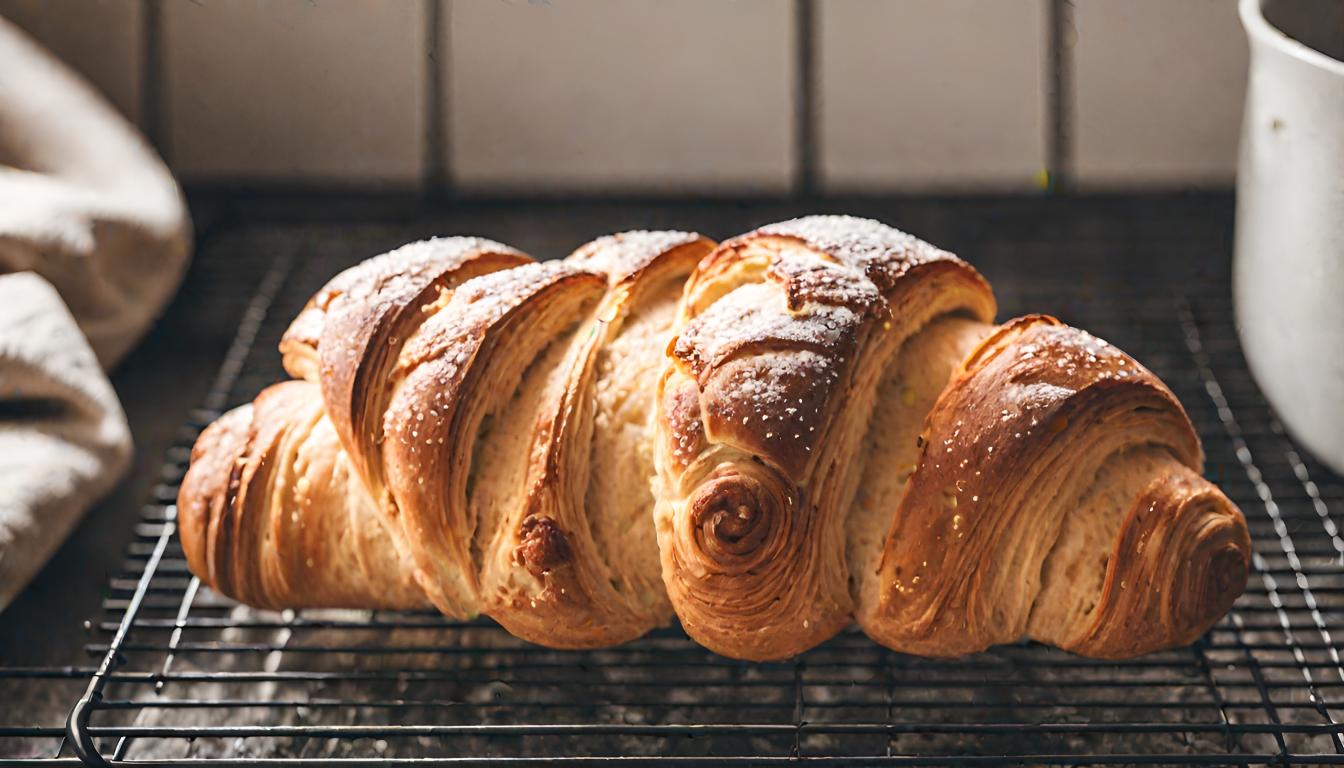Embarking on a culinary journey, this article delves into the art of crafting the perfect croissant bread. A staple in French bakeries, croissant bread combines the flakiness of a croissant with the heartiness of bread. This guide not only walks you through the intricate process of making this delightful pastry but also sprinkles in expert tips, serving suggestions, and answers to frequently asked questions
Introduction to Croissant Bread
Ah, croissant bread! Just the name conjures up images of quaint Parisian cafes and the irresistible aroma of freshly baked goods. Originating from France, this delightful pastry has danced its way into hearts worldwide, thanks to its unique combination of a croissant’s flakiness and bread’s satisfying substance.
A Brief History and Origin
Croissant bread, a marvel of the baking world, has roots deeply embedded in French culinary traditions. It’s a twist on the classic croissant, which itself has an interesting history. Legend has it that the croissant was born out of a celebration in Vienna, Austria, over the defeat of the Ottoman Turks, with the pastry’s crescent shape mimicking the emblem on the Turkish flag. This delectable treat made its way to France, where it evolved into what we now know as the croissant.
Popularity and Variations
Over time, the croissant has been adapted and reinvented in numerous ways, leading to the creation of the croissant bread. This variation maintains the buttery, layered texture of traditional croissants but is baked as a loaf, making it more versatile for various culinary creations. From a simple breakfast accompaniment to a base for decadent desserts, croissant bread has gained immense popularity for its adaptability and delicious taste.
In the next section, we’ll dive into the essential ingredients and tools you’ll need to embark on this baking adventure. And remember, for more insights into the world of professional baking, King Arthur Baking offers a wealth of Professional Baking Guides to enhance your baking skills.

Ingredients and Tools
Essential Ingredients
To create the perfect croissant bread, you’ll need a handful of basic yet crucial ingredients. These include:
- Flour: The backbone of your bread, providing structure.
- Butter: For that quintessential flaky texture and rich flavor.
- Salt: A pinch to enhance all the flavors.
- Yeast: The magical ingredient that makes the dough rise.
- Milk: Adds tenderness to the dough.
- Sugar: Just enough for a hint of sweetness.
- Egg: For the golden, glossy finish on your loaf.
Each ingredient plays a pivotal role in creating the layers and flavors that define croissant bread. Don’t hesitate to experiment with alternatives, like using different types of flour or milk, to suit your dietary preferences or to add a unique twist to the classic recipe.
Required Baking Tools
Equally important are the tools that transform these ingredients into a sumptuous loaf. Here’s what you’ll need:
- Mixing Bowls: For combining your ingredients.
- Rolling Pin: Essential for rolling out and laminating your dough.
- Dough Cutter: To precisely cut your dough.
- Loaf Pan: To give your bread its classic shape.
- Pastry Brush: For applying that egg wash to get a shiny crust.
- Stand Mixer (optional): Makes kneading the dough easier.
Having the right tools at your disposal simplifies the process and brings you closer to achieving that perfect loaf of croissant bread.
In the next part, we’ll step into the heart of the process – preparing the dough and baking your croissant bread. For additional baking ideas and inspiration, check out Food52’s collection of Innovative Baking Ideas.

As we venture further into the art of making croissant bread, we arrive at the most exciting part: the recipe process. This stage is where your ingredients and tools come together in a delightful symphony. We’ll walk through the steps of preparing the dough, laminating it with butter, and finally, baking it to golden perfection. Let’s roll up our sleeves and dive into the heart of croissant bread making!
The Recipe Process
Preparing the Dough
The journey to a perfect loaf starts with the dough. Here’s how to get it just right:
- Mixing: Begin by combining warm milk, yeast, and sugar in a mixing bowl. This mixture should sit until it’s frothy – a sign that the yeast is active.
- Adding Ingredients: Gradually add flour, softened butter, and salt to the yeast mixture. Mix until a soft, pliable dough forms.
- Kneading: Knead the dough until it’s smooth and elastic. This can be done with a stand mixer or by hand on a floured surface.
- First Rise: Place the dough in a greased bowl, cover it, and let it rise until it doubles in size. This is where the magic of yeast transforms the dough.
Laminating the Dough
Lamination is what gives croissant bread its signature layers:
- Rolling Out: After the first rise, roll the dough into a rectangle.
- Butter Layering: Place thin slices of butter over the dough, leaving a margin at the edges.
- Folding: Fold the dough like a letter, enclosing the butter.
- Refrigerating: Chill the dough to ensure the butter doesn’t melt.
- Repeating: Repeat the rolling, folding, and chilling process several times to create multiple layers.
Baking the Croissant Bread
Now, it’s time to bake:
- Final Shape: Roll the laminated dough into a log and cut it into slices.
- Second Rise: Place the slices in a loaf pan and let them rise until puffy.
- Egg Wash: Brush the top with an egg wash for a golden crust.
- Baking: Bake in a preheated oven until the bread is golden brown and cooked through.
Each step in this process is crucial to achieving the light, airy texture and rich flavor of croissant bread. Patience and attention to detail are your best friends here.
Moving forward in our croissant bread odyssey, we now focus on the nuances that can elevate your baking from good to great. In this part, we’ll share some expert tips and tricks, along with common pitfalls to avoid. These insights will help you navigate the challenges of baking and ensure your croissant bread turns out wonderfully every time.
Tips and Tricks
Expert Baking Tips
- Temperature Matters: Ensure your butter is cold enough to handle but not too hard. This balance is crucial for perfect lamination.
- Precision in Measurement: Baking is a science. Use a kitchen scale for accurate measurements, especially for flour and butter.
- Dough Consistency: The dough should be soft but not overly sticky. If it’s too sticky, add flour one tablespoon at a time.
- Patience with Proofing: Allow the dough to rise fully during both proofing stages. This patience pays off in the bread’s texture.
- Oven Hot Spots: Be aware of your oven’s hot spots. Rotate the bread halfway through baking for an even golden crust.
Common Mistakes to Avoid
- Rushing the Process: Don’t speed through the resting and chilling times for the dough. These are essential for developing flavor and texture.
- Overworking the Dough: Handle the dough gently during lamination. Overworking can lead to tough bread.
- Skipping Egg Wash: The egg wash is not just for appearance; it gives the bread a beautiful sheen and helps in browning.
- Inconsistent Butter Layering: Ensure the butter is evenly distributed for uniform layers in your bread.
- Ignoring Dough Temperature: If the dough becomes too warm, return it to the fridge. Warm dough can cause the butter to melt and ruin the layers.

s we near the completion of our croissant bread journey, it’s crucial to know how to serve and store this delightful creation. After all, the joy of baking is as much in savoring the bread as it is in making it. In this part, we’ll discuss some creative serving suggestions and the best practices for storing your croissant bread, ensuring it remains delicious for as long as possible.
Serving and Storage
Serving Suggestions
Croissant bread is incredibly versatile, making it a fantastic addition to various meals:
- Breakfast Delight: Slice it thick and toast it lightly. Serve with butter, jam, or honey for a simple yet luxurious breakfast.
- Savory Sandwiches: Use it as the base for a gourmet sandwich. The buttery layers add a fantastic texture to both cold and grilled sandwiches.
- Dessert Base: Transform it into a decadent bread pudding or French toast. The bread’s richness enhances these classic desserts.
- Elegant Appetizers: Cut into small pieces and use as a base for canapés or bruschetta, offering a unique twist to your appetizers.
Storage and Preservation
To keep your croissant bread fresh:
- Room Temperature Storage: Store it in an airtight container at room temperature for up to 3 days.
- Refrigeration: For longer storage, wrap it in foil or plastic wrap and refrigerate for up to a week.
- Freezing for Longevity: Croissant bread can be frozen for up to 3 months. Wrap it securely in plastic wrap and then in foil before freezing. Thaw at room temperature or in the refrigerator when ready to eat.
- Reheating: Warm it in the oven or toaster for a few minutes to revive its crispness and warmth.
Proper storage ensures that your croissant bread remains as delightful as the day it was baked, allowing you to enjoy its buttery goodness to the fullest.

s we wrap up our comprehensive guide on croissant bread, it’s time to address some of the most common queries bakers have. This FAQ section aims to clear up any lingering doubts and provide you with the confidence to bake this delightful bread with ease. Let’s dive into these frequently asked questions and their answers.
Frequently Asked Questions
Q1: Can I use all-purpose flour instead of bread flour?
A1: Absolutely! All-purpose flour works well for croissant bread. It may result in a slightly different texture, but the bread will still be delicious.
Q2: How do I know if my dough has risen enough?
A2: The dough should roughly double in size. This usually takes about 1.5 to 2 hours. If you’re unsure, gently press the dough with your finger. If the indentation remains, it’s ready.
Q3: My dough keeps tearing during lamination. What should I do?
A3: If the dough tears, it might be too cold or overworked. Let it rest for a few minutes at room temperature. If butter leaks out, sprinkle a bit of flour over the area to help seal it.
Q4: Can I make croissant bread without a stand mixer?
A4: Yes, you can! While a stand mixer makes the process easier, you can certainly mix and knead the dough by hand. It just requires a bit more effort and time.
Q5: How long can I store croissant bread?
A5: Croissant bread can be stored at room temperature for up to 3 days, in the refrigerator for up to a week, and in the freezer for up to 3 months.
Q6: Can I add fillings to my croissant bread?
A6: Definitely! Feel free to experiment with fillings like cinnamon sugar, chocolate chips, or even savory options like cheese and herbs. Just be mindful of the moisture content of your fillings, as too much can affect the dough.
Delving into the world of baking doesn’t stop with croissant bread. For those who enjoy the fusion of flavors, our Lemon Blueberry Cheesecake recipe is a delightful next step, blending zesty citrus with sweet berries. And if you’re inclined towards savory adventures, our Vesuvio Potatoes offer a unique Italian culinary experience that’s sure to impress.


